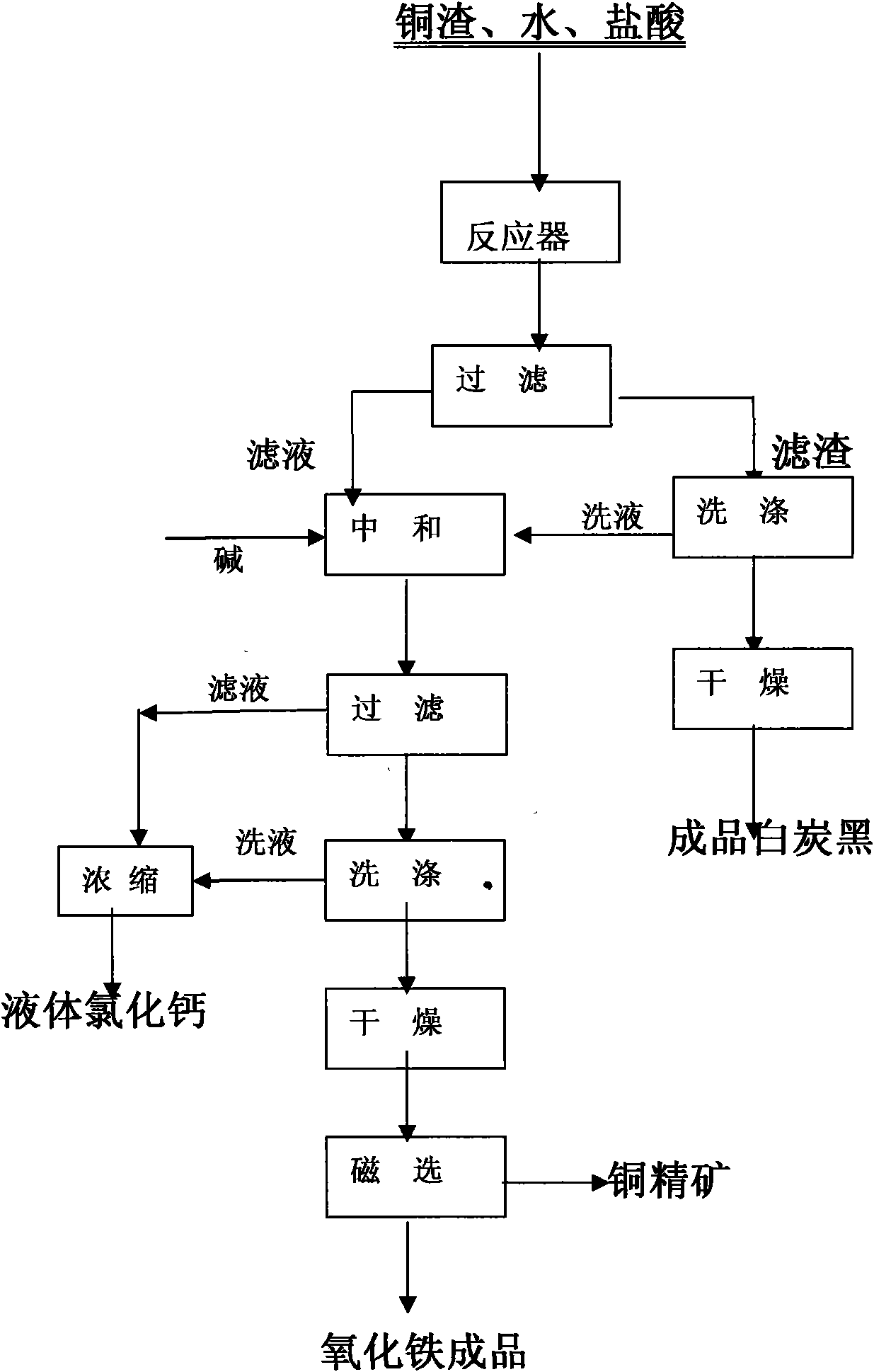Method for comprehensively recovering Fe, Cu and Si from copper smelting slag
A technology of copper smelting slag and copper slag, which is applied in the field of copper, separation of iron, and silicon dioxide, can solve the problems of low utility, low resource utilization rate, and difficult separation of existing technologies, and achieve resource integration The effect of high utilization rate, high product added value and short process flow
- Summary
- Abstract
- Description
- Claims
- Application Information
AI Technical Summary
Problems solved by technology
Method used
Image
Examples
Embodiment 1
[0022] Grind the copper slag to below 5mm and weigh 100g for use, prepare 600ml with industrial hydrochloric acid at 35wt%, put it in a 1000ml beaker, then place it on an adjustable electric furnace and heat it to 50°C, turn on the stirrer and adjust it to 60r / min, slowly add Copper slag (solid-to-liquid ratio is controlled at 6:1), and the final acid concentration of the reaction is controlled to be PH<4. After 15 hours of reaction, the filter cake is washed three times through a centrifugal filter (4000 rpm, 3 minutes), and the filter cake is dried to obtain Finished white carbon black (silicon recovery rate reaches 88%, and purity is 85%); 1.2 times of iron powder amount of copper ion concentration is added in the filtrate, and through 30 minutes of replacement reaction filtration recovery metallic copper (copper recovery rate reaches 76%); Add alkali (lime water) to the filtrate to adjust the pH value to 6-7, filter through a centrifugal filter after 10 minutes of precipita...
Embodiment 2
[0024] Grind the copper slag to below 0.6mm and weigh 100g for use, prepare 1000ml with industrial hydrochloric acid at 50Wt%, put it in a 2000ml beaker, then place it on an adjustable electric furnace and heat it to 85°C, turn on the stirrer and adjust it to 500r / min, slowly Add copper slag (solid-liquid ratio is controlled at 10:1), and after 30 minutes of reaction, control the final acid concentration of the reaction to PH≤2, age for 20 minutes, and wash the filter cake three times by centrifugation (2500rpm, 5 minutes), filter The cake is dried to obtain the finished white carbon black (silicon recovery rate reaches 89%, and the purity is 91%); alkali (lime water) is added to the filtrate to adjust the pH value to 67, and after 20 minutes of precipitation, it is filtered through a centrifugal filter, and then passed through Drying, crushing, and magnetic separation are used to obtain iron oxide finished products (iron recovery rate is 85%), and copper recovery rate is up to...
Embodiment 3
[0026] Grind the copper slag to below 0.6mm and weigh 100g for use, prepare 2000ml with industrial hydrochloric acid at 40Wt%, put it in a 2500ml beaker, then place it on an adjustable electric furnace and heat it to 95°C, turn on the stirrer and adjust it to 300r / min, slowly Add copper slag (solid-liquid ratio is controlled at 20:1), and after 60 minutes of reaction, control the final acid concentration of the reaction to PH<4, age for 20 minutes, pass through a centrifugal filter (2500rpm, 5 minutes) and wash the filter cake three times, The filter cake is dried to obtain the finished white carbon black (silicon recovery rate reaches 92%, and the purity is 93%); alkali (lime water) is added to the filtrate to adjust the pH value to 7-9, and after 20 minutes of precipitation, it is centrifuged and filtered. The cake is dried, crushed and separated by magnetic separation to obtain iron oxide finished product (the iron recovery rate is 87%), and the copper recovery rate reaches ...
PUM
| Property | Measurement | Unit |
|---|---|---|
| recovery rate | aaaaa | aaaaa |
Abstract
Description
Claims
Application Information
 Login to View More
Login to View More - R&D
- Intellectual Property
- Life Sciences
- Materials
- Tech Scout
- Unparalleled Data Quality
- Higher Quality Content
- 60% Fewer Hallucinations
Browse by: Latest US Patents, China's latest patents, Technical Efficacy Thesaurus, Application Domain, Technology Topic, Popular Technical Reports.
© 2025 PatSnap. All rights reserved.Legal|Privacy policy|Modern Slavery Act Transparency Statement|Sitemap|About US| Contact US: help@patsnap.com

